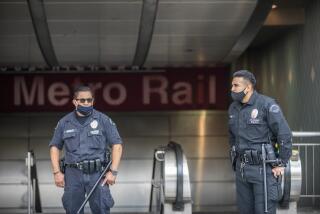Secrecy Is No Way to Make Wheels Turn : To do its job, MTA board must keep public fully informed
Today the full board of the Metropolitan Transportation Authority takes up what may be the last chapter of Franklin White’s tenure as MTA chief executive officer. Specifically, the board is to decide whether to support last Friday’s 3-2 committee vote urging that White be fired.
We continue to question the timing of this development, mostly because the CEO was less than four months away from a scheduled evaluation, which would have been the proper time to act, whichever way it went. And dismissing White would not be a magic bullet. The MTA’s problems go beyond the CEO, and also involve the conduct of the board.
The White matter has been handled badly. That’s important to see regardless of today’s outcome. Among those treated poorly in this episode has been the public. What played out on Friday smacked of old-style, closed-door politics. You didn’t actually need a smoke-filled room to realize that things didn’t smell quite right.
CONTROVERSIAL MEETING: Yes, the closed session on White started out well within the Brown Act provision permitting private sessions on personnel matters. But many more board members showed up as the meeting continued, leading some observers to conclude that the session should have been opened to the public. Yes, the Los Angeles city attorney said later that the meeting had been within the privacy provision of the act. But by that time the image of the gathering had been damaged.
The problem here is simply stated. This particular meeting invites all manner of invidious speculation: that the firing of White was recommended because he had resisted pet projects of board members, making tough decisions rather than failing to do so; that board members had no valid reason to sack White and thus had to move secretively; that Mayor Richard Riordan was out to get prominent, Tom Bradley-appointed black officials, White being one of them.
It did not have to come to this. On Tuesday, for example, Riordan set forth a vision for the future of mass transportation in Los Angeles. He explicitly stated that even the MTA’s scaled-down, 20-year building plan is unrealistic and requires rethinking. He emphasized that planning should be based on a backbone of better bus service, and not mainly on rail. He said he could not imagine the Red Line subway extending beyond North Hollywood but that the San Fernando Valley’s needs will be served and that there were several options.
SEEMS A BIT LATE: We certainly have no quarrel with a fresh look at the region’s mass transit plans. Some parts of the mayor’s vision, particularly as it regards bus service, make great sense. But we have a question.
Why wasn’t this vision communicated last March as the MTA board (of which Riordan is the most powerful member) was about to embrace a plan that the mayor said then would never be built, suggesting it was unrealistic?
Why wasn’t it made clear publicly then, as the mayor says now, that he expected White to envision and sell a completely new plan, rather than simply scale back?
The public had no inkling of this. You will see that in the days ahead, as residents and officials in the Valley and across the city fret over just what kind of rail system they might get. And therein lies the value of keeping the public informed through full airing of all board members’ views. Therein lies the groundwork for any certain-to-be-controversial personnel moves down the line. Therein lies the framework for the kind of consensus badly needed here, and among those who control the purse strings in Washington and Sacramento. The process must be open. Too much money and too many interests are involved.
More to Read
Sign up for Essential California
The most important California stories and recommendations in your inbox every morning.
You may occasionally receive promotional content from the Los Angeles Times.

![Irvine, CA - July 16: Gina Osborn, shown at her home, is the former head of Metro security is suing the agency for firing her after she filed a claim with the Inspector General. Photo taken at her home Tuesday, July 16, 2024. Gina Osborn, a former FBI agent who was the agency's first chief safety officer, "was summarily terminated by [Chief Executive] Stephanie Wiggins," said her attorney, Marc R. Greenberg. Osborn says in claims that she butted heads with Metro's CEO over security as the agency was trying to put a good face on its efforts to clean up crime and loitering. (Allen J. Schaben / Los Angeles Times)](https://ca-times.brightspotcdn.com/dims4/default/c1419ae/2147483647/strip/true/crop/5981x4000+9+0/resize/320x214!/quality/75/?url=https%3A%2F%2Fcalifornia-times-brightspot.s3.amazonaws.com%2F46%2F07%2Fa88ac0b7466895ee4e137839d93c%2F1467168-me-former-metro-security-chief-18-ajs.jpg)







